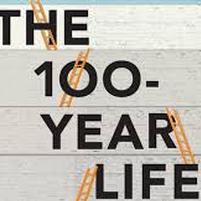I absolutely loved The 100 Year Life, a book by two London Business School professors, Lynda Gratton and Andrew J. Scott. It was one of the first books to examine how our ability to live longer lives will transform the world of work. Whenever I encounter middle aged friends who feel stuck in their job/career/marriage/fill-in-the blank, I say "Read this! You're going to live to be 100. Make the most of it!"
If you're familiar with The 100 Year Life and/or the related research on aging and the future of work, the first two-thirds of the book's sequel - The New Long Life: A Framework for Fourishing in a Changing World - covers familiar ground. There's a lot more data in the second book, and an explicit focus on how advances in technology intersect with ageing trends.
But I was mainly interested in the final third of the book, where the authors stop identifying challenges and start talking about solutions. There are loads of actionable ideas in here for how we adjust work, school and public policy to accommodate longer, more productive lives. In an earlier blog I explored why it's in the interest of businesses to adapt to embrace an ageing workforce. Here, I'll zero in on the potential changes we need to see in the workplace to suppor this age of longevity:
- Create Multiple Points of Entry - In the first book, Gratton and Scott argue that we need to abandon the traditional idea of a neatly arranged, three-staged life comprised of education, followed by career and then retirement. Instead, they argue, we need to embrace a multiple-phased life course where people keep learning throughout their lives, take lots of breaks and dip in and out of jobs and careers. If you buy into this idea, then it follows that employers should make it easier for people to enter - and exit - careers across time. On the hiring front, this means evaluating workers based on the skills they can bring to the table - an age-neutral metric - rather than narrowly defined academic credentials (which tend to figure more prominently if you're hiring people straight out of university). It also means allowing valuable employees the ability to ramp up and ramp down their work commitments across their lives in your company by supporting educational breaks, sabbaticals or a stint in the charitable sector.
- Revisit retirement - Part and parcel of making one's career path more flexible is rethinking the concept of retirement. I was speaking to a 60 year-old friend recently who told me that she easily sees herself working full-time for at least another 15 years, if not 20. She's not alone. Scott and Gratton advocate replacing mandatory retirement ages with optional retirement paths, including the option to carry on working full-time as well as instituting assorted phased paths to retirement. But workers need to be educated about these options much earlier on in their careers, so that they can plan effectively for the future. I'm doing some consulting for a company that wants to begin offering mid-career professionals workshops in how to tool up for a "second act" so that they have the option to start a new career - with whatever new skills they might need - before retirement confronts them.
- Embrace a culture of flexibility - In the wake of the Covid19 pandemic, the suggestion that workplaces embrace a culture of flexibility now seems prescient, rather than radical. But the authors aren't just talking about working from home, a change many companies are not only tolerating now, but accelerating. They're also talking about allowing employees to elect a four-day week. Again, the driver here isn't solely the burgeoning number of older workers in the global economy who might wish to gradually ratchet down their work week. It's the fact that once you abandon the concept of a three-stage life, workplaces need to accommodate the non-linear nature of our personal and professional lives across the entire life course.
- Encourage lifelong learning - As employees become more mobile and there are greater numbers of temporary workers in the economy, one might expect corporate spend on learning and development to drop. But Scott and Gratton argue that this is one area where rapid technological change may engender more, rather than less, training. At a minimum, workers - particularly older ones - will need to be up to date on all the latest technology. Digital platforms also substantially lower the costs of providing training (because it can be done at scale), while enabling such training to be more easily customised, monitored and measured. A friend of mine runs talent developmetn at a global financial services company. His company gives all employees a $1000 stipend annually to spend on professional development training as they see fit. My corporate clients have told me that they see an investment in L and D as a tool for employee retention in an era characterised by a mobile workforce. If workers feel that they are growing professionally, they are less likely to leave after a couple of years, even if the pay isn't particularly high.
- Combat ageism - As companies rush to embrace diversity and inclusion in their talent management, it's important to combat ageism alongside sexism, racism and other traditional forms of workplace bias. I remember being on a hiring panel a few years back and fighting my own instinct not to take an older candidate seriously, simply because of his age. Given the demographic realities confronting us, this sort of attitude is not only wrong-headed, it's bad for business. The authors cite research showing that older workers are much more likely to possess precisely the sorts of 21st century, transferrable skills - like communication, problem-solving, and creativity - that will be most needed in an increasingly automated age.
While Scott and Gratton do a nice job of outlining the institutional changes needed to underpin an age of longevity, I was less convinced by their socio-cultural prognosis for change. They make a plea for us all to become "social pioneers" to support the changes required at the macro-societal level. Sounds good, but where do I sign up? In other words, how do such longevity champions emerge? Through osmosis? Education? The charitable sector?
I look forward to hearing their answer in Book Three. Working title: Leading the Age of Longevity. (And yes, I'd love a cut of the royalties while I'm at it...)
About the Author
Delia Lloyd is a Visiting Fellow at the Oxford Institute of Population Ageing. A seasoned writer and editor, she worked for a decade in radio, print and online journalism. Her reporting and commentary have been featured on outlets including The New York Times, The Washington Post, The Guardian and The BBC World Service.
Opinions of the blogger is their own and not endorsed by the Institute
Comments Welcome: We welcome your comments on this or any of the Institute's blog posts. Please feel free to email comments to be posted on your behalf to administrator@ageing.ox.ac.uk or use the Disqus facility linked below.













